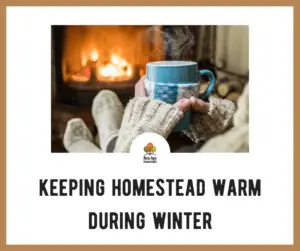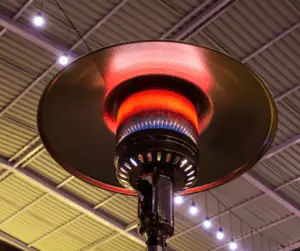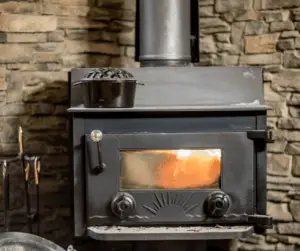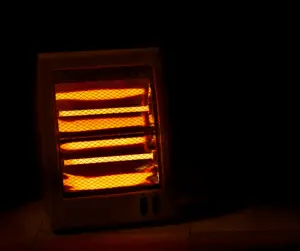Winter months are our arch-enemy when it comes to homesteading. Here are five options to defeat it and claim victory; this way, you can stay nice and warm even during the coldest times.
I remember when I first moved off-grid; the first night was frigid. I had no firewood, no electricity for electric heaters, and no wood-burning stove.

It made me rethink my decision before the first night was over until I discovered a few methods to keep warm. If you’re looking for better ways to keep your homestead warm during winter, I’m with you.
I’ve created an article that lists several options to keep warm, no matter how cold it is outside. A few of them will be more traditional, while the others are a bit more modern.
I’m also going to list a few critical factors to consider before acting on anything: this includes safety, efficiency, and accessibility.
Further, into the article, I’m also going to recommend a few great items to help you stay warm, with and without heaters. Let’s jump into it now.
Critical Factors To Consider
Safety
The first point you must consider is the safety aspect. Wintertime typically has more fires due to a particular reason: heating elements.
I’ve not only heard of several cases of injury or worse to friends or relatives, but I’ve experienced this myself with a wood-burning stove.
I won’t get into the specifics, but whichever method you choose, make sure that you follow safety precautions as closely as possible.
Also, it would be an excellent idea to install smoke detectors in each room, and if possible, get one with a carbon monoxide detector.
Efficiency
If there is one thing that needs to be paid attention to for those living off-grid, it’s efficiency, which is a chore in itself.
You likely either have electricity powered via solar or even no electricity at all, but if you do, power efficiency is critical.
This is also valid for wood burning stoves, as some will burn through three logs considerably faster than others will; air-flow is a significant cause.
Whatever the case is, just make sure whichever option you opt for is efficient enough to be comfortably powered by your power source.
Accessibility
If there is one thing that proves challenging during the winter, it’s the challenge of accessibility. This could mean access to firewood or merely a power source.
You need to make sure you have access to all of these things before the winter sets in.
Firewood, for one, can become wet and frozen during very cool temperatures, deeming it impossible to use in a heater.
You should make sure you have plenty of power and consider a large battery bank. I’d recommend placing all of the firewood underneath some sort of structure.
Top 5 Ways To Keep Your House Warm
1: Wood Burning Stove
This is the best option on this list if you want to take the most traditional approach. A single wood-burning stove can easily keep an entire home warm and cozy, depending on the size.
I’ve used several, and they’re not difficult to use at all; the only negative is that you’ll always have to cut firewood; this may prove difficult on small properties.
There are several types of wood-burning stoves; some are small, perhaps for a single room, and others, best for whole homes.
Nevertheless, as long as you keep the chimney and elbows clean, one of these bad boys will set you up nicely. Just make sure you never use fatwood as a primary fuel source, only as a starter.
If you do opt for a wood-burning stove, keep in mind that you’ll have to cut a hole in your home for the exhaust piping, or as some call it, the chimney.
2: Electric Heater
If you have an electricity source, it may suit you better to opt for an electric heater. In the old days, electric heaters used a significant amount of electricity.
However, the newer models have gotten considerably more power-efficient, making them a good option.
There are several types of electric heaters featuring scorching coils and others that act as a radiator but are best or personal use.
I’ve always had the best luck with heating coils, but these use more electricity. Still, they’re much more power-efficient than ever before.
Some types have a fan built-in, which helps spread around more heat while using less surface area, saving power consumption.
3: Propane Heater
I’ve used this type of heating for nearly a decade; it’s undoubtedly a smart option. Propane isn’t precisely expensive when you consider how long it lasts with propane heaters.

Typically, the propane heaters are placed on the wall, but there are also portable heaters. I’ve used the buddy heaters several times during hunting, and they work great.
I’ve used a small-sized one that warmed my entire cabin; they get very, very warm. The only negative to propane heating is the safety aspect.
Although it’s improbable, a leak could occur, so it’s necessary to place several detectors all around the area, and then even more. You do not want to go to sleep with a propane leak.
Propane heaters are also an excellent backup for when you’re running low on firewood or electricity.
4: Insulation
The first challenge I ran into when I began living in my cabin full time was lack of insulation. I had not planned on living there full time initially, but I couldn’t help myself; deer season was in.
I had to quickly install insulation because even the wood-burning stove proved difficult at heating the cabin; it’s as if there are no walls; it really can get that bad.
After I installed fiberglass insulation, though, the cabin would warm up very quickly and stay that way for hours, even after all heaters were disabled. You’ll want to make sure that the floor, walls, and the ceiling is insulated well.
There are several ways to do this; my favorite is fiberglass insulation; but you can also use Aerogel, which is costly, or Cellulose, which is fire resistant.
If you have a substantial amount of insulation, the entire home will be much more efficient and will stay cooler throughout the summer months too.
5: Seal Drafts
If you want to avoid the inevitable cold draft hitting you while you’re relaxing in your homestead, you’ll want to do a few things to prevent this. The first thing to do is to seal off the doors.
If you feel around the gaps of your door during a windy or chilly day, you may feel some air finding its way through. If this is the case, then placing foam strips in between the door and frame will suffice.
If you notice air seeping through near the bottom of the door, then you could place strips there to prevent this. You should also seal any gaps you find in the attic or floor corners.
Drafts alone can make a house drop significantly in temperature, so if you have a problem keeping your home warm, this may be the culprit.
This problem can be easily fixed using spray foam in areas where strips prove problematic, such as in the attic or crawl space.
A Few Useful Items
Insulated Curtains
A handy addition to have are insulated curtains. You’re probably very familiar with the cool feeling when sitting near a window during winter.
The glass allows the outdoor’s coolness to pass right on through, indirectly cooling the air near the window inside the home. To prevent this, you may consider hanging insulated curtains over the windows.
This will prevent the coolness from reaching a significant amount of air inside. Regular curtains will help, but they will provide nowhere near the amount of protection that insulated curtains will.
Thick Rugs
If you live off-grid, you likely have hardwood flooring, so it’s easier to clean up after a day out in the field, as tracking mud inside is probably a not so rare occurrence.
Hardwood floors are horrible at insulating and essentially provide the same annoying aspect that windows do, by allowing the cool air to cool the flooring, which then cools the home’s inside.
A thick rug can help combat this; make sure the rug’s bottom is heavy, so it stays flat on the ground, and do not get a carpet that is light and fluffy; these will not work as well.
Heating Blankets
If you can spare a bit of electricity, perhaps consider purchasing an electric blanket. These blankets have a small lining inside that heats to a mild warm temperature.
I’ve used these several times in the past, and they’re excellent at keeping you warm. They’re especially great if you’ve yet to set up a proper heating system.
There are also heating sheets, which are slept on top of instead of under, though I’d recommend the comforter if you have to choose between the two. It should not use much electricity, but it’s great if you’re strapped on Kw.
Smoke & CO2 Detectors
If you’re going to have a wood-burning stove or a propane heater, then having a smoke and CO2 detector is a must-have.
There are several types available, but I’d recommend buying one that is operated on battery power. I’d also recommend placing one in each room just in case one fails.
Some smoke detectors have a feature that’ll alert you via the internet if a fire occurs while you’re away from home, which is useful if you have internet.
Frequently Asked Questions
Which Battery Banks Are Best?
If you’re going to be using a wood-burning stove or propane heater to keep your home warm during the winter, I’d recommend a battery bank if sourcing wood or propane is complicated.
There are various types, but I’d recommend getting one that can sustain an electric heater for up to a few days, which should be enough time to source for wood in a snowstorm, for example.
The first one will be the Jackery Portable Power Station Explorer 500, which is plenty of power storage to get you through a pinch using a mini space heater, which is energy saving.
How Can I Store Propane?
I’ve used propane as a fuel source for my heater for years, and my number one suggestion is to make sure you have enough of it because it’s not fun when you run out during a cold front.
For starters, keep the tank in an open area, away from any potential damages (lawnmower, kids being kids, etc.), and make sure it’s away from home, by 25 feet or more.
You should inspect for leaks at least once per week, as not only could this be dangerous, the least that would happen is the propane leaking and leaving you with no fuel.
Which Wood Is Best For Heating?
For those of you who want to opt for a wood-burning stove, you’ll want to use a long-burning wood with a consistent burn temperature.
My favorite to use is oak wood, which is very commonly found. It burns slowly while also reaching adequate temps; it’ll take a bit longer to become seasoned, though.
Maple and ash are two more types of firewood excellent for wood-burning stoves, and they typically become seasoned a little faster than oak in my experience.
Verdict
If you’ve been debating which option would suit you best for keeping your homestead warm during the winter, I hope this article has served you well by explaining various options.
I think it would be best to opt for a wood-burning stove; however, this would require labor in terms of collecting firewood.
The electric heaters will be a great choice, especially if power consumption is not a worry.
Propane is fantastic, but you’ll need to refill frequently unless you have an enormous tank.
It doesn’t take much to heat a home, so there shouldn’t be a need for a crazy setup. Whichever the case, please be careful with how it’s setup. Stay toasty!


